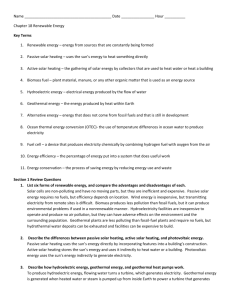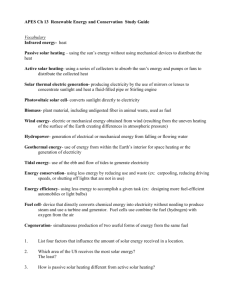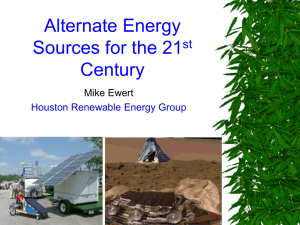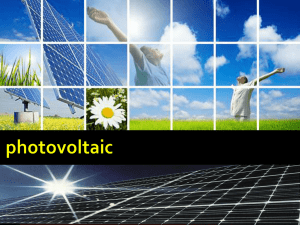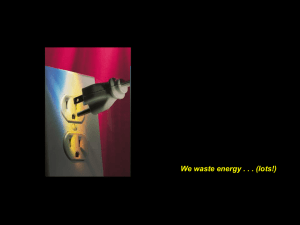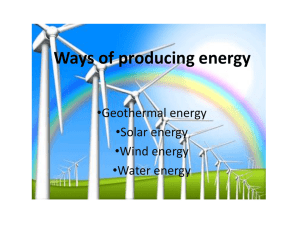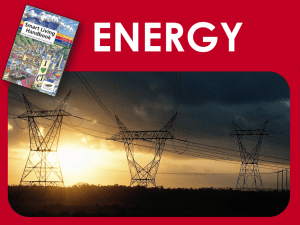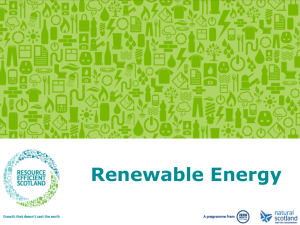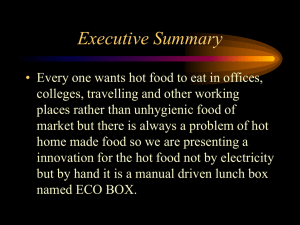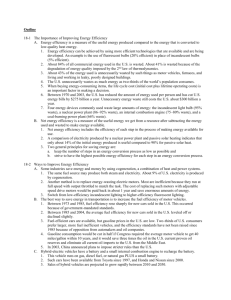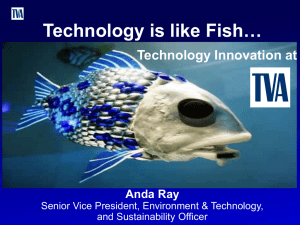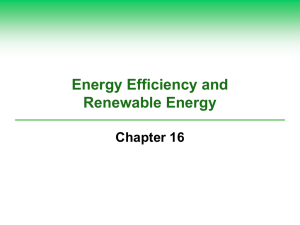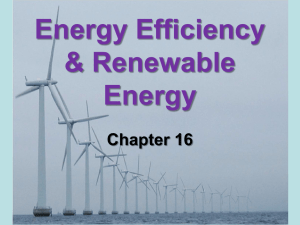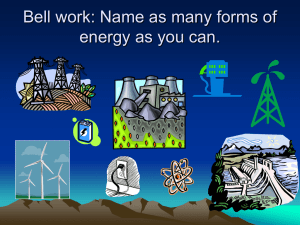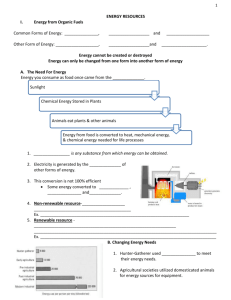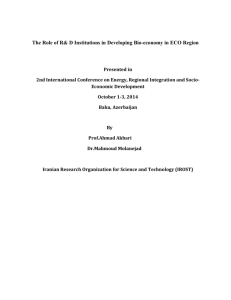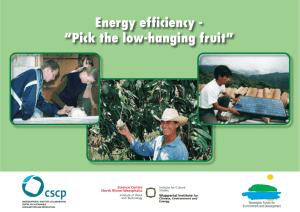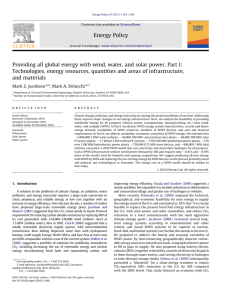Chp. 18: “Renewable Energy Sources”
advertisement
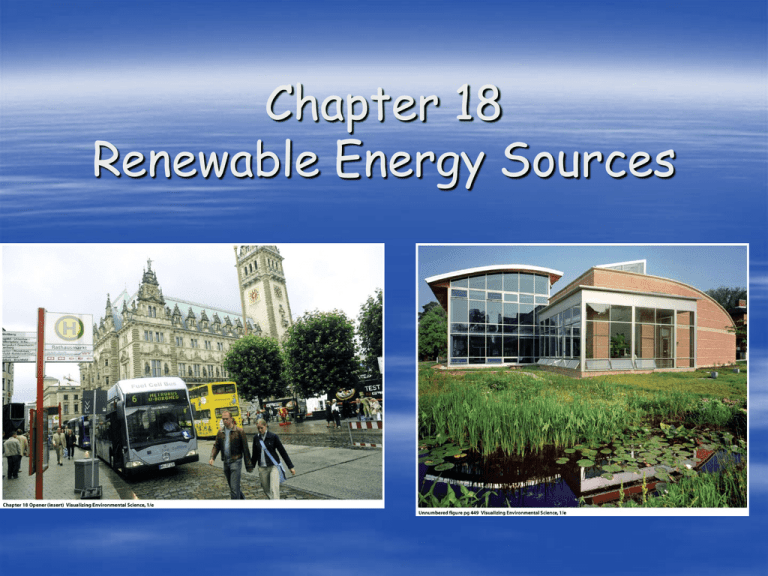
Chapter 18 Renewable Energy Sources Cleaner Cars, Cleaner Fuels Cars release a lot of pollution 2005 Bush administration 7% improvement in mileage 22.2 mpg 2020 30.5 mpg Diesel engines need work Cleaner Cars, Cleaner Fuels Energy Policy Act of 2005 Tax credits Energy-efficient autos Liquid hydrogen as a fuel What does the future hold? Electrical Generation Costs Direct Solar Energy Energy directly from the sun Tremendous amount Always available Must be collected Active Solar Heating Collectors absorb solar energy Pumps or fans distribute heat Primarily for heating water Passive Solar Heating No mechanical devices to distribute heat New home design Room temperature is steady Convection Save on heating! A Passive Solar Home Photovoltaic (PV) Solar Cells Convert sunlight into electricity Thin wafers or films No pollution Minimal maintenance Photovoltaic (PV) Solar Cells Can be used in remote areas Good choice for developing countries: why? School, home use Photovoltaic (PV) Solar Cells Can look like conventional roofing Prices are coming down Future progress is critical Solar Thermal Electric Generation Sun’s energy concentrated by mirrors, lenses Heat a working fluid Fluid is circulated to boil water Steam generates electricity Solar Thermal Electric Generation Backup system needed Very efficient No pollution produced Must be costcompetitive Hydrogen As A Fuel Source Could be the fuel of the future Where does the hydrogen come from? Electrolysis Must use renewable fuel source to obtain the hydrogen! Few pollutants produced when burned Can be used for transportation Solar-Generated Hydrogen Use PV cells for electrolysis of water Currently not very efficient Still expensive Would need new distribution system for transportation Future development is critical Solar-Generated Hydrogen Fuel cells Electrochemical cell Like a battery Major carmakers working on it Indirect Solar Energy Indirect use of sun’s energy Biomass, wind power, hydroelectricity Biomass Energy Wood, plants, animal wastes Potentially renewable: why? Burned to release energy Half of human population relies on Cooking, heating Biogas Mixture of gases Similar to natural gas Animal wastes Biogas digesters Decompose wastes Use gas for cooking, lighting Solid remains are fertilizer Can also be used to power fuel cells Biogas Digester Biomass As A Liquid Fuel Methanol, ethanol Gasohol: mix gasoline and ethanol Biodiesel Plant, animal oils Becoming more popular Burns cleaner than regular diesel Ethanol Sugarcane, corn, wood, agricultural and municipal wastes Government subsidizes Good outlet for some wastes Problems Land and water use Soil erosion Decreased food production Wind Energy Fastest growing energy source No waste, emissions Electricity Costs are declining Denmark is a world leader Need steady winds Great Plains of U.S. Wind Power Is On The Rise! Wind Energy Problems Birds and bats killed by turbines Avoid migration routes Operate only at certain times Monitor the project Visual pollution Maple Ridge, NY Massachusetts coast Hydropower Flowing or falling water spins turbines Most efficient way to produce electricity 19% world’s electricity 2200 U.S. plants Hydropower Problems Damages ecosystem, species Displaces people: Three Gorges Dam High construction cost Reduces downstream flow Reservoirs eventually fill in Danger of collapse Degrades river Increase in waterborne disease: schistosomiasis Geothermal Energy Use energy from Earth’s interior Big potential source Electricity Hydrothermal reservoir: hot fluid Bring fluid to surface to generate electricity Geothermal Energy Geothermal Energy Emits very few pollutants Is it truly renewable? Land may subside Geothermal Heat Pumps Used for heating and cooling Ground temperature relatively constant Underground pipes carry water Fluids circulate Expensive to install Use is on the increase: why? Very efficient! Tidal Energy Use power of the tides to generate electricity France, Russia, China, Canada Very few ideal locations May be damaging to ecosystems Conservation & Efficiency Energy conservation Using less energy Reduce use, waste Carpooling Energy efficiency Using less energy for a task More fuel-efficient cars Both very important! Energy Consumption Trends Use is on the increase Greatest increase in developing countries: why? Energy-Efficient Technologies Appliances, automobiles, light bulbs, furnaces, etc… “Superinsulated” buildings May cost more, but will save money! Energy-Efficient Technologies National Appliance Energy Conservation Act Sets national standards Much greater efficiency today Invest in energy improvements now to save money in the long run Automobile Efficiency Has improved since 1970s: why? Increased use of minivans, trucks, SUVs Efficiency must continue to improve Cogeneration Combined heat and power (CHP) Recycling “waste” heat Generate electricity, use steam before cooling it back down Electric Companies & Energy Efficiency Make more money, generate less electricity Incentives for conservation Help consumers save electricity Light bulbs, furnaces Company doesn’t have to invest in new power generation Electric Companies & Energy Efficiency Use cogeneration to save energy Improve electricity grids Some energy lost in transmission Plan for future use Energy Conservation At Home Average household: $1500/year on utilities Use energy-efficient technologies Better insulation, windows Seal cracks Replace inefficient appliances Energy Conservation At Home

